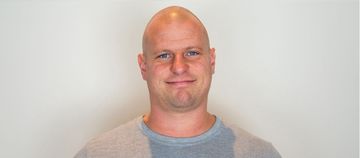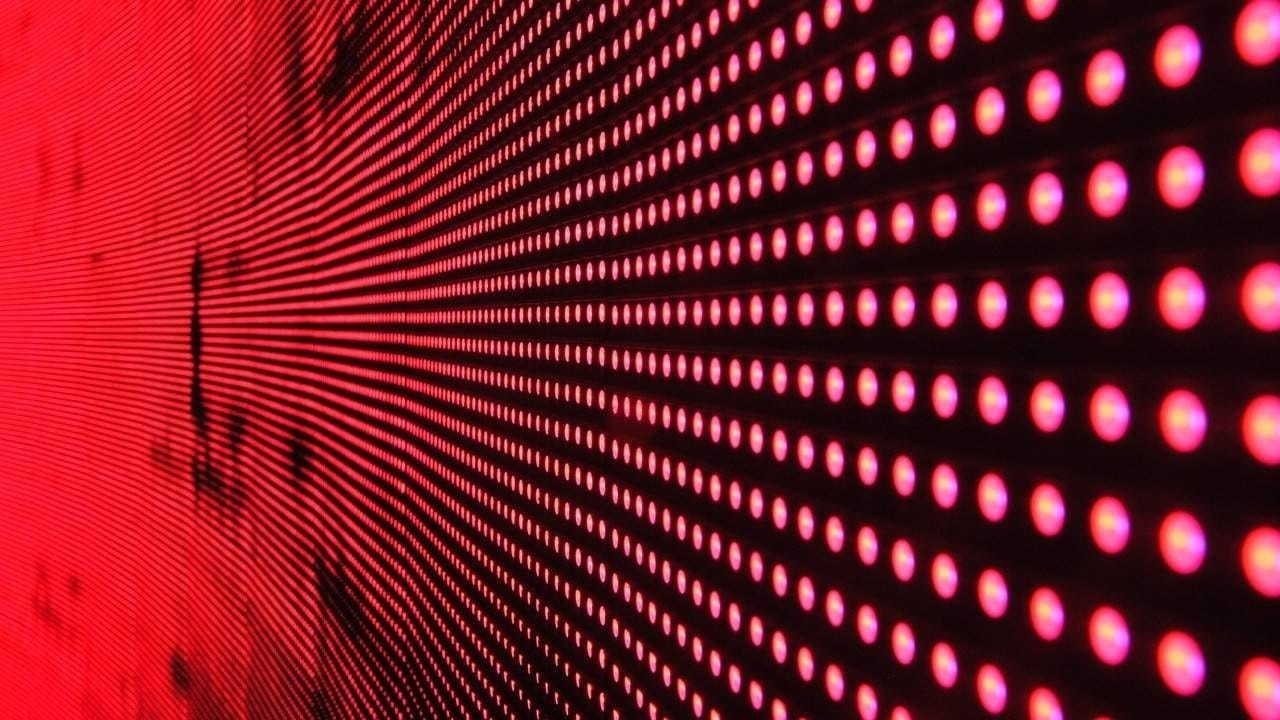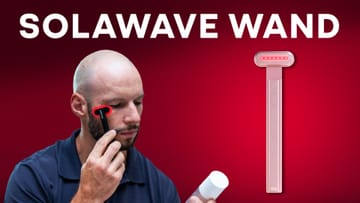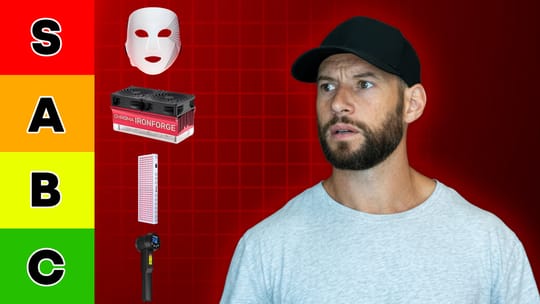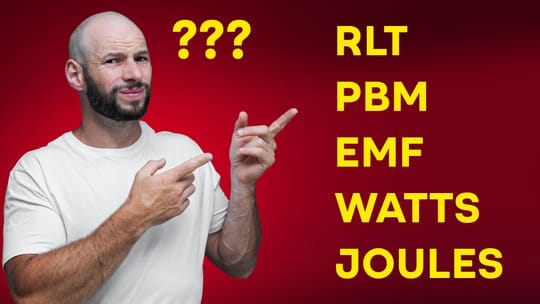We've been in the red light therapy space for more than 6 years years, since 2017. And yet, sometimes the question "does red light therapy work" come up. Or people ask "is red light therapy science-based at all?!"
Usually, it's people who don't really have a deep understanding of red light therapy that ask the question. Of course, it's only natural that people who don't understand red light therapy ask this question because there are more and more people entering the space.
We've all been beginners at one point. So, this blog post is created to give some concrete examples of how red light therapy does have benefits and that it does work. But first, let's talk about the principles of red light therapy:
What Is Red Light Therapy And Does It Affect Human Physiology?
In this section, I'll explain what red light therapy is and why it's very plausible from a scientific standpoint that it affects your body's physiology
History Of Lasers And Red Light Therapy
Before consider whether red light therapy works, I'll first make a detour and explain what red light therapy is and how it came to be. To discuss how red light therapy originated, I'll have to take a detour into the history of light therapy.
Let's begin at the beginning:
From the 1970s onward, lasers were used for their therapeutical benefits (1). Skin ulcers were the first health condition to be treated with what is called "Low-Level Laser Therapy" (LLLT).
Back then, LEDs weren't even invented let alone a commercially available alternative to other light bulbs.
Nowadays, LLLT is carried out with LED light bulbs, even though scientific discussions about whether LEDs are as effective as lasers continue to this day (2; 3; 4; 5). Slowly the scientific consensus has shifted though, especially in the late 2010s, accepting that LEDs are as effective as lasers.
There's a huge problem with lasers for residential use: they can be damaging as they can generate high heat levels and damage tissues. If you normally use LEDs according to the instructions, you won't get any significant side effects.
So let's consider what both lasers in LLLT and LEDs in red light therapy have in common: both emit light, or "photons" from a physics standpoint. Those photons hit your skin.
Not all photons are reflected off your skin but many of them actually penetrate into your body. There's a lot of discussion actually on how deep these photons penetrate your body, but suffice it to say, it's at least a few centimeters and at most a few inches - in both human and animal studies (6; 7; 8; 9; 10).
I don't want to discuss how deep the light is actually penetrating, as that's a topic for another day. Instead, I want to prove to you - in a later section - that red light therapy does have tremendous effects on many aspects of human physiology.
So let's assume that the photons do enter your body and therefore affect your cells. What happens in that case?
Well, several mechanisms have been proposed explaining how and why red light therapy (which uses LEDs) and LLLT (which uses lasers) work:
The Light Spectrum
Both LEDs and lasers emit "photons". Not all photons are created equal, as light can exist at different "wavelengths". It's easier for me to display that light spectrum from a physics point of view with different wavelengths below:

If you look at the light spectrum above, you see 1) ultraviolet light; 2) visible light (which you can see as a human); 3) infrared light. Both ultraviolet and infrared light are thus invisible to the naked human eye, although you can see it with scientific equipment.
Visible light is made up from all the colors of the rainbow. Infrared and ultraviolet light are most easily understood by referring to sunlight's effects when you spend time in it.
Infrared light is what makes sunlight feel hot on your skin. For that reason, you feel warmer when you're sitting in direct sunlight compared to the shade. The same is true for ultraviolet light, which can give you a sunburn if you spend too much time in the sun when that sun is higher up the sky.
In the shade, your risk of getting a sunburn goes down massively, compared to direct exposure, because the ultraviolet dose reaching your skin goes down.
Now, these two examples of infrared and ultraviolet light are straightforward and most people can easily intuitively understand both. Visible light affecting their body's biology is somewhat harder.
Blue light, for instance, when it enters your eyes, increases your wakefulness. For that reason when LED lights in your house or office send out lots of light in the blue part of the light spectrum, you'll stay awake for longer.
All parts of the visible light spectrum can affect your body's physiology though. Violet, blue, green, yellow, orange, and red, all have different effects.
Red light therapy and LLLT also use infrared light, although usually under 1,100 nanometers in length. The red part of the light spectrum starts at 600 nanometers, so there's a very small 500 nanometer band that's used in both LLLT and red light therapy.
You can visualize that part of the light spectrum below:

Most red light therapy panels on the market today use wavelengths of around 620 at the least and in the 900s at the most. LLLT research, however, also ventures in the 1,000 nanometers (nm) range, which today's panels have not yet done.
These wavelengths between 600 and 900 are non-heating. The effect of red light therapy is therefore different from an infrared sauna. Infrared saunas heat your body up from the inside out by having the photons enter your body. Regular saunas heat up your body by heating up the air around you. And, lastly, the goal of red light therapy is not to heat up your body but to have these photons of light enter your body in a non-heating way instead.
How?
Let's explore that process in more detail:
Photons Entering The Human Body And Affecting Your Biology
Both affect the energy-generation process in your cells through your "mitochondria" (11; 12). Your "mitochondria" are the energy-producing factories of your cells. While the language is somewhat complicated, a process and step in that energy generation called "cytochrome c oxidase" is affected when you shine different types of red and infrared light on them.
As a result, the following happens:
"The leading hypothesis is that the photons dissociate inhibitory nitric oxide from the enzyme, leading to an increase in electron transport, mitochondrial membrane potential and ATP production." (11)
"Adenosine Tri-Phosphate", or "ATP", is usually posited as the main unit of account for energy in biological organisms.
(Not all scientists agree on the thesis that ATP is the main unit of account for energy generation - I'll ignore these theories right now as they don't have scientific consensus (13; 14; 15)).
Other explanations exist though on how red light therapy works. For instance, it's also hypothesized that different types of red and infrared light affect the ion exchange from cells, thereby affecting your biology at the cellular level.
The earlier mechanism of light affecting your mitochondria also presupposes an interaction between light and minerals, as the cytochrome c oxidase depends on iron and copper inside the human body - which are originally sourced from your diet.
On the ion exchange influence, Lucas Freitas and Michael Hamblin, two important researchers within the LLLT and red light therapy industry write:
"Another hypothesis concerns light-sensitive ion channels that can be activated allowing calcium to enter the cell. After the initial photon absorption events, numerous signaling pathways are activated via reactive oxygen species, cyclic AMP, NO and Ca2+, leading to activation of transcription factors. These transcription factors can lead to increased expression of genes related to protein synthesis, cell migration and proliferation, anti-inflammatory signaling, anti-apoptotic proteins, antioxidant enzymes. Stem cells and progenitor cells appear to be particularly susceptible to LLLT."
That all sounds very complicated.
And to make matters worse from a theoretical perspective, many other mechanisms have been posited about how red light therapy and LLLT work (16; 17; 18). Examples are affecting gene expression, reactive oxygen species, signalling molecules, transcription factors, and more - I'll skip all these. The only thing you need to know is that many different -both competing and non-competing - explanations exist as to why LLLT and red light therapy work.
Instead of digging much deeper into physiology, I'm going to take the pragmatic approach and consider some simple health outcomes in medical studies.
A simple example would be whether a placebo-controlled study is able to demonstrate an effect if participants are treated with red light therapy or with a sham intervention regarding changes in blood pressure.
If such an effect can be demonstrated, then you and I know that red light therapy works, independent of its exact biological mechanism. So, next up, let's explore that topic:
Where Is The Evidence? The ~7,500 Studies Investigating "Low-Level Laser Therapy" (LLLT) Or Red Light Therapy
Currently, Vladimir Heiskanen, who is also a researcher in the LLLT space, has collected a spreadsheet of different studies. Here you can see that spreadsheet with 7,500+ studies - you can access it freely by clicking it:

As of this moment of writing, 7,400+ studies have been categorized in that Excel sheet. For each study, Vladimir records:
- The tissue type and outcome within that tissue type
- The first author of the study
- Study title
- Year of publication
- Journal of publication
- The title of the study
- Study type (such as randomized controlled trial or another type)
- Notes (any special circumstances related to the study)
- The wavelength in nanometers used in the study
- The power output in mW/cm2 used - if you wish to learn more about this principle then read the guide on red light therapy dosing
- The total dose in Joules and Joules per cm2 - which is the effective power output over time measurement. Again, read the dosing guide if you want to learn more
- Treatment time in seconds
- The results and interpretation of the data
Hence, Heiskanen's Excel sheet is an excellent source if you want to dig deeper into any red light therapy (LLLT) study.
(I updated this blog in 2023. This blog is originally from 2022).
In the rest of this blog post, I'll explore a few case studies that do show that red light therapy works:
Case Study 1: Osteoporosis (Bone)
Again, I'm referring to the Excel sheet by Vladimir Heiskanen here to show you the individual studies I'm quoting.
In that Excel sheet, on April 8 2022, studies #315 - 333 denote LLLT and the bone, specifically in the area of osteoporosis. Please keep in mind that in the future, this Excel sheet may be updated, so that the numbers 315 to 333 no longer correspond to the osteoporosis topic.
Nevertheless, you can keep finding the outcome by simply searching for the category of "bone" and the subcategory of "osteoporosis". So let's get a general impression of what the red light therapy & LLLT research tells us in this case:
In total, a little fewer than 20 studies exist on the topic. Two of these studies are carried out in humans, and the rest on animals, mostly rats.
Only two out of 19 studies are negative, and the rest of the outcomes are either neutral (one) or positive (16). That's an 84% rate of positive outcomes for LLLT on countering osteoporosis.
Looking at the research, the wavelengths used vary from the high 700s to the low 1,000s - so the exposure pattern is a little bit different than the 660nm and 850nm found in most red light therapy panels, potentially supplied with alternative wavelengths like 630 and 810nm.
(I and Alex will come back to the topic of "alternative" wavelengths in a later installment of this red light therapy education series later on.)
Here's a showcase of some of the outcomes of the studies, that I'm quoting directly from the Excel sheet. The Excel sheet quotes, in turn, are taken from the PubMed studies - I'm highlighting important parts
"ALN, ADS, and PBM significantly increased healed bone strength in an experimental model of DBM-treated CSFD in the catabolic phase of bone healing in osteoporotic rats." (19)
"All measured outcomes were significantly decreased post-treatment in all treatment groups. Laser plus exercises showed a higher significant effect than exercises with a least significant effect in the laser group in reduction of pain and quality of life." (20)
"LLLI can effectively improve osteoporosis, increase BMD, improve bone structure and improve bone biomechanical properties in old rats; at the same time, it increases the levels of serum BAP and OCN and the number of osteoblasts in the bone marrow, suggesting that the osteogenesis function of osteoblasts is enhanced." (21)
"Combined treatment of PW laser and alendronate significantly enhanced bone repair in an experimental model rat of TIDM and OP." (22)
"Concurrent treatments of PW LLLT and alendronate produced the same effect on osteoporotic bone. Since the PW LLLT has osteogenic effects, different parameters should be investigated to verify whether an appropriate PW LLLT protocol in combination with a proper(s) anti osteoporotic agent(s) might reverse the detrimental effects of OP." (23)
"On the basis of our methodology and results, we conclude that LLLT improves and accelerates bone repair within titanium scaffolds in both ovariectomized and healthy rats, when compared to animals not subjected to radiation." (24)
"Biomechanical test findings showed positive effects of the PW LLLT and alendronate administration on increasing bending stiffness and maximum force of the osteoporotic bones compared to the healthy group. However, laser treatment of OVA-d rats significantly increased stress high load compared to OVA-d control rats.
PW LLLT preserved the cancellous (trabecular) bone of vertebra against the detrimental effects of OV-induced OP on bone strength in rats compared to control OV rats." (25)
"In conclusion, there was new bone formation in the groups that received 20 and 30 J/cm(2) when compared to control groups, but over time, the dose of 30 J/cm(2) showed better stereological parameters when compared to 20 J/cm(2)." (26)
Then, there's the neutral outcome study:
"PW LLLT did not increase the biomechanical parameters of osteoporotic bones compared to controls and healthy rats. PW LLLT associated with alendronate treatment significantly increased stress high load in OVX-d rats compared to the healthy group." (27)
"LLLT treatment led to higher amount of newly formed bone and granulation tissue compared to control." (28)
"Our results indicate that laser therapy improves bone repair process in contact with Biosilicate as a result of increasing bone formation, as well as COX-2 and Cbfa-1 immunoexpression, angiogenesis and collagen deposition in osteoporotic rats." (29)
"Low-level 904-nm laser (50 mJ/cm(2)) accelerated the repair process of osteopenic fractures, especially in the initial phase of bone regeneration." (30)
I've chosen the more easily worded conclusions here. Then, there are the two negative outcomes:
"Results showed that laser alone had a detrimental effect on trabecular bone volume, and cortical bone volume in groups GIOP and OVX-D compared to those in the healthy group." (31)
"Although HILT alone did not effectively increase lumbar and total hip BMD, HILT combined with exercise was more effective than exercise alone at increasing lumbar BMD after 24 weeks of treatment, with effects lasting up to 1 year." (32)
Also, I completely understand that the language from these conclusions or abstracts is impenetrable if you haven't read the full study. For that reason, I've added the link to every single study so that you can verify the answers for yourself.
Suffice it to say that the above case study does prove that LLLT and red light therapy have significant effects on countering osteoporosis in most studies.
No study is perfect though and in the two studies with a negative outcome, there's even debate about why that result was found. Red light therapy with incorrect parameters can create counterproductive results, as the light is a kind of stressor on the mitochondria too - called "hormetic stressor" - so overdosing can be detrimental in the same way cold exposure or exercise can be.
Case Study 2: Different Addictions, Such As Opioids And Alcohol (Brain)
Currently, study #339 - 344 (in 2022) concern the effect of red light therapy & LLLT on different types of addiction.
In this case, all six studies have positive outcomes. Four out of six studies are on humans, and the rest on animals.
Wavelengths used in the studies are 514 nanometers (nm), 633, 810, and 830. The latter two 810nm and 830nm are dominant here - once again, you'll see that 660nm isn't necessarily universally applied within LLLT research, even though most panels predominantly use them.
Of course, there are many other parameters used in the studies, such as power output, treatment time, location of treatment, and more, so be sure to check them out on the Excel sheet if you want to learn more.
So, once again, here are the outcomes of all of the studies:
"Improvement in BDI-FS and increase in, beta-endorphin level were observed. These results suggest that laser therapy can be useful as an adjunct treatment for alcoholism." (33)
"We report here our findings from our second randomized controlled trial to evaluate unilateral transcranial photobiomodulation as a treatment for opioid use disorder."
"Our primary outcome was changes in pre-treatment opioid craving scale (OCS) minus baseline, and we found using a mixed model that the active group had a highly significant treatment * time benefit over the sham group, p < 0.0001, effect size at the last follow-up of 1.5.
The active treatment benefited those not on buprenorphine as well as those not on it. The TimeLine Follow Back measure of opioid use was significantly better in the actively treated group, p = 0.0001, with an effect size of 0.45. We observed no adverse effects." (34)
"Unilateral t-PBM to the hemisphere with a more positive hemispheric emotional valence was an effective and safe treatment for opioid cravings as well as for depression and anxiety. Our results also lend support to the underlying premises of DBP."
"The effect size for the differences between active and sham was 0.73. For the active treatment from before and after treatment the effect size was 1.51 and for the sham, 0.45. The HDRS improved from a baseline of 15.1 to 8.8 (SD 10.3) a week after the active treatment and to 13.3 (SD 12.9) after the sham (p = 0.0071). HARS improved from 14.7 to 8.0 (SD 13.2) after the active treatments and to 14.3 (SD 16.0) after the sham, p = 0.08." (35)
"LILT and L-NAME (20, 50, and 100 mg/kg) per se significantly decreased escape jump count and stool weight in morphine-dependent naloxone-treated mice (p < 0.01). Coadministration of LILT and L-NAME (20, 50, and 100 mg/kg) also reduced escape jump and stool weight (p < 0.05) but with no synergetic or additive response.
Here, LILT at this fluence may show its maximal effects on NO and therefore no noticeable effects appeared during coadministration use. Moreover, LILT and L-NAME follow the same track of changes in escape jump and stool weight. Conceivably, it seems that LILT acts partly via NO system, but the exact path is still obscure and rather intricate. The precise mechanisms need to be clarified." (36)
"One-way ANOVA showed that the LILT which applied immediately or 15min prior to naloxone injection significantly decreased total withdrawal score (TWS).
These results suggest that LILT prior to naloxone injection attenuates the expression of withdrawal signs in morphine-dependent rats. Further studies may elucidate the likely role of LILT in clinical management of opioid withdrawal syndrome." (37)
"The case reports are from 42 consecutive patients in his practice with OUD where he has given 382 treatments over 18 months, as needed. The author's subjective clinical observations were that of the 42 patients, 26 (62%) consistently had responses to the UtPBM (as described in the case reports) that were easily observable to the patient and the author as strikingly beneficial, 8 (19%) had helpful, but not remarkable responses, and 8 (19%) had no noticeable response." (38)
Again, the results hopefully speak for themselves. Six out of six studies show positive effects of countering different aspects of addiction, such as the natural levels of feel-good compounds such as endorphins, decreased amount of substance use and abuse, reduced cravings and depression, changed behaviors, and improvements in withdrawals.
Sounds quite good, right?
Once more, a positive effect has been shown for LLLT and red light therapy. Of course, with six current studies, a lot more research is needed to build upon current results and confirm the current pattern.
Case Study 3: Alzheimer's Disease (Brain)
Initially, I just didn't want to include outcomes such as Alzheimer's disease because it occupies studies #347 to #402. Summarizing the outcomes of Alzheimer's disease here would take up a lot of time and space and most people wouldn't even read it.
Suffice it to say that the 50+ studies on Alzheimer's are all positive right now, there's not a single study with a negative outcome as of this moment.
I've really triple and perhaps even quadruple-checked the outcomes here and continued to find the same results. 100% of 50+ studies on Alzheimer's Disease are currently positive in relation to red light therapy.
Once more, don't believe me, just double-check my findings in the Excel sheet HERE.
Wavelengths included range from the low 600s range to the high 1,200s range once again. Dosages vary big time across studies, and yet, all of them do show positive outcomes
My Methodology And Interpreting These Results
I've tried to keep my methodology simple for formulating an answer to the question "does red light therapy work"
I just took the best resource of all the red light therapy and LLLT data, Heiskanen's Excel sheet, started at the top, and scrolled down for some examples that would easily demonstrate that LLLT and red light therapy work.
And, the three examples I picked, showed a range of ~84% to 100% effectiveness of the therapy involved here.
Could you argue that my methodology is biased and that I've selectively picked a few instances where LLLT is really positive, while in reality, results are less rosy? Sure, you can make that argument, but, I would invite you to simply scroll through the Excel sheet yourself and get an impression of the pattern of the positive versus negative outcome ratio.
That argument can be easily debunked because by scrolling through the document, you'll see a consistent 80%+ green to a maximum of 20% red ratio - hence proving my point. Sometimes, there are a lot of neutral studies too though.
Having said that, what's important to keep in the back of your mind is that in case there are many negative studies, these can also be explained through incorrect red light therapy parameters. Figuratively speaking, if you use a dose of 1,000 Joules you'll get a negative outcome, just as doing 10 heavy squat workouts per week will lower your strength levels after either one week or three weeks - it doesn't matter when you test.
Of course, I could have inserted more examples above, such as muscle recovery after exercise, bone repair and osteoblasts in relation to bone tissue, and a lot of other examples, but I'm confident that you - as a reader - can research the topics for yourself.
Personal Experience With Red Light Therapy
Alex has written extensively about the benefits of red light therapy in his life. For instance, he describes the following effects of red light therapy:
- Alex's tooth pain was massively reduced. His wisdom teeth caused issues for his in the past, but with red light therapy, the pain was bearable. He had to use red light therapy for 5-10 minutes per session, and after two weeks he got the results he wanted.
- Also, after a few months, his teeth and mouth went completely pain-free. When I went to travel for a few weeks, for a health expo, and didn't use any red light therapy, the pain eventually returned again.
- Alex's skin quality improved. The number of pimples is clearly reduced
- He used the red light therapy on my naked skin, and experienced bigger balls with it. Yes, we know it's going into too much detail, but hey, many people use red light therapy to increase their testosterone levels, so I might as well mention this fact!
- A cyst Alex had in the 2017-18 period reduced in size
Also, Bart, the writer of this article has the following benefits from red light therapy:
- Much quicker recovery after workouts and the ability to do many more workouts per week. When the red light therapy is used directly before a workout, performance also shoots up big time.
- Better sleep, relaxation, and overall well-being. This effect is especially noticeable when the days become shorter in Holland. Nevertheless, the red light therapy seems to add benefits above and beyond the benefits you'd be getting from sunlight exposure alone.
- Less overall sleep needed per night.
That's it.
Many other people report similar benefits as I have, sometimes with huge improvements. If you're interested about a YouTube video of Alex describing these effects, check:
A video in which Alex stops using red light therapy for four weeks and tells you about the benefits he starts missing!
In this video, Alex Fergus fact checks the benefits of red light therapy
This video shows many different testimonials they have with red light therapy
Lastly, let's conclude:
Conclusion: Overwhelming Evidence Exists That Red Light Therapy Works
Questioning whether red light therapy works for improving your health is a bit like questioning whether moving more or improving your diet improves health. Sure, you can make the argument if you're extremely skeptical, but, in a way, you're coming across as a bit of a fool maintaining that position.
Thousands of studies show benefits in red light therapy, and my three case studies clearly show that there are all-around beneficial effects to red light therapy.
What To Read Next: Red Light Therapy Blog Recommendations
Rather than ending your quest here with this article, I highly recommend keeping reading about red light therapy to expand your knowledge. Here are some 100%-free blog recommendations I and others of the Alexfergus team have written about the topic:
- Start Here - Light Therapy 101 & Buyers Guide
- What Is Red Light Therapy?
- How To Use Red Light Therapy 101: The Best Guide For Starters
- 36 Powerful Red Light Therapy Benefits
- Discount Codes, Deals & Recommendations - Red Light Therapy
This is a post by Bart Wolbers. Bart finished degrees in Physical Therapy (B), Philosophy (BA and MA), Philosophy of Science and Technology (MS - with distinction), and Clinical Health Science (MS), has had training in functional medicine, and is currently chief science writer at Lighttherapyinsiders.com
